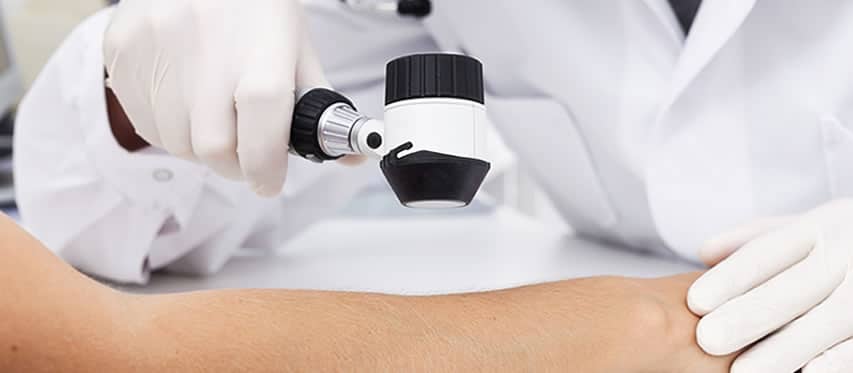Skin Cancer Screening in Sarasota, FL

Did you know that approximately five million people are diagnosed with skin cancer every year in the United States? An annual skin cancer screening with a board-certified dermatologist will help greatly reduce improve your prognosis. The three most common types of skin cancer are Basal Cell Carcinoma, Squamous Cell Carcinoma, and Melanoma.
Contact Us Today to Schedule a Skin Cancer Screening
What is a Skin Cancer Screening?
A skin cancer screening at American Dermatology Associates is a visual inspection of your skin by Dr. Trent. No blood work is necessary during a skin cancer screening. Basal cell carcinoma, squamous cell carcinoma and melanoma are the most common types of skin cancer, with melanoma being the most deadly. It is important to regularly self-examine your skin, as well as schedule a yearly appointment for a skin cancer screening by a dermatologist. A skin cancer screening can help detect skin cancer early.
How Is Skin Cancer Diagnosed?
A skin cancer diagnosis should be performed after you undergo a skin cancer screening. To diagnose skin cancer, your doctor will review all of your symptoms and will check your skin for any unusual growths or abnormal patches. If skin cancer is suspected, a biopsy will be performed on the growth or area of skin in question. Once the biopsy is tested and the results are reviewed, the type of cancer can be determined and a treatment plan will be created.
Call to Schedule an Appointment
Types Of Skin Cancer
As mentioned previously, there are three common types of skin cancer. They affect different layers of the skin and are named for the different skin cell types that can become cancerous.
Basal Cell Carcinoma
Basal cell carcinoma is a type of skin cancer that occurs in the basal cell layer of the skin. This is the most common type of skin cancer in fair-skinned people and it usually occurs on areas of the skin that have had sun exposure, such as the face. This type of skin cancer rarely spreads to other parts of the body.
Squamous Cell Carcinoma
Squamous cell carcinoma is a type of skin cancer that occurs in the squamous cells. This is the most common type of skin cancer in dark-skinned people and it usually occurs on areas of the skin that are not commonly exposed to the sun, such as the legs or the feet. When fair-skinned people develop squamous cell carcinoma, it tends to occur in sun-exposed areas like the face, ears, head and neck. This type of skin cancer can spread.
Melanoma
Melanoma is the most dangerous and aggressive type of skin cancer. Melanoma is the most likely of the three types to spread to other parts of the body. It occurs in the melanocyte (pigment) cells of the skin, and can form on any part of the body, regardless of the amount of exposure to the sun.
For more information on skin cancer, skin cancer screenings or skin cancer treatment, visit www.skincancer.org today.
How Accurate are Skin Cancer Screenings for Detecting Cancer?
Since the development of skin cancer screenings, instances of skin cancer deaths have declined significantly. Between 2014 and 2018 alone, melanoma death rates declined by 7% each year in adults under the age of 50. Deaths declined by 5% each year in adults over age 50. While skin cancer can cause death or significant health consequences, the disease is very treatable. Early detection is the key to long-term survival related to melanoma, the most serious form of skin cancer. The accuracy of skin cancer screenings is credited with the improvement in survival rates among melanoma patients, and declines in skin cancer diagnoses for nonmelanoma skin cancers. This is because self-exams and screenings, when combined and performed regularly, are very good at identifying precancerous lesions and new skin cancer growths before they invade surrounding tissue to a large degree.
Are Skin Cancer Screenings Painful?
No. Skin cancer screenings are not painful. To check for this disease, the provider carefully looks over the skin on every part of the body. The examination may involve light or a special instrument called a dermatoscopy, which magnifies the visual field by several times. If the provider discovers a mole or growth that exhibits characteristics of some type of skin cancer, they may take a biopsy of the skin. Biopsies can also be performed in a comfortable manner. Before scraping cells from the growth, the doctor administers a local anesthetic to the skin. This quickly numbs the area so no discomfort is felt.
How Soon after Screening can I Schedule Treatment?
If your doctor finds a suspicious growth during your skin cancer screening, they will perform a biopsy during that same visit. The cell sample is sent to the lab for microscopic examination. The pathology report is usually in our office within seven to 10 days of the skin cancer screening. If the biopsy results indicate skin cancer, we schedule an appointment right away to discuss appropriate treatment options. The entire process of screening, diagnosis, and treatment may take place in a matter of just a few weeks.
How Do You Prepare for a Skin Cancer Screening?
Once your skin cancer screening has been scheduled, you can prepare for your visit in the following ways:
Perform a self-examination sometime before your visit. This allows you to note any changes in existing moles or the development of new spots on your skin. The findings of your self-examinations provide important data that help your dermatologist fully know your skin as it relates to skin cancer.
Before your appointment, remove nail polish or artificial nails from fingers and toes. Skin cancer can develop on nail beds, so it is important that your doctor can observe these areas.
Come to your appointment with clean, makeup-free skin.
Wear your hair loose or be prepared to take your hair out of braids, ponytails, or buns so your doctor can examine your scalp.
What Skin Cancer Screening Questions Should be Asked?
When you see your doctor for an annual skin cancer screening, you may ask a number of questions that can help you understand what is happening, what may influence your risk for skin cancer, and what may happen if you are diagnosed with skin cancer. Some patients like having answers to “what ifs” and some prefer to take one step at a time, digesting only that they are being screened for skin cancer and that their results may be completely normal. Your appointment for skin cancer screening is completely personal to you so you may have unique questions that no one else has. Please feel free to talk with us during your appointment. We’re happy to let you know what we are doing during every part of your screening and provide you with information regarding your moles and other growths. This conversation helps you know your skin better and what you can look for in subsequent self-exams.
How Long Does Skin Cancer Screening Take?
Skin cancer screenings are very quick and completely painless. Appointments typically take less than one hour, with the examination itself requiring about 20 minutes. If you are scheduling your first skin cancer screening with a new doctor, expect your examination and medical history review to take a bit longer. It is important to obtain all of the information we can to get to know your skin and your personal risk factors for skin cancer.
What Is Self-Screening for Skin Cancer?
When examining your skin, look for pre-existing moles or new ones that look irregular. Moles should be round and uniform in color and appearance. The borders should be smooth. Some moles may have varying degrees of color; however, they should not be abstract in shape. Additionally, any moles that are enlarging or changing colors warrant further evaluation.
What Should I Look for When Examining My Moles?
Follows the ABCDEs of moles: asymmetry, border irregularity, color that is changing or not uniform, diameter greater than six millimeters (typically the size of a pencil eraser), changing size, shape, and color.
What Parts of My Body Should I Check?
Moles can develop on just about any part of your body. However, areas that are exposed to the sun should be checked first. Look for changes in moles or for the development of new lesions. Be sure to check your scalp, under your arms, your back, and your legs.
What Should I Do if I Find an Irregular Mole?
You do not need to panic if you find an irregular mole. Moles can change or even develop as you get older, and that does not automatically mean they are malignant. You should schedule an appointment with your doctor to have them examined, possibly excised, and biopsied if needed.
Does Having a Lot of Moles Increase My Chance of Cancer?
Having a lot of moles does not necessarily increase your risk of developing skin cancer. However, if you have a lot of moles, it is important to perform self-screening examinations and see your doctor frequently for routine skin checks.
Are Some Types of Moles More Concerning than Others?
Moles that are irregularly shaped or miscolored may be cancerous or precancerous. A formal skin examination can identify the moles and excise them if necessary. If you would like to learn more about skin cancer screening or would like to schedule an appointment, fill out this form or contact the Sarasota office today.
What People Say About Us!
Refer friends to Dr. Trent every time I know they need an excellent dermatologist. Dr. Trent is fabulous!”
~ Connie (Patient for 7 years)
Click here to read more reviews.

